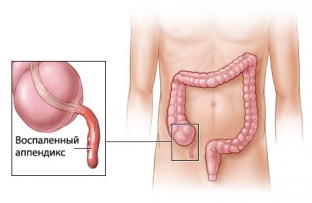In case of appendicitis – inflammation of the rectal appendage – it is very important to notice signs of a life-threatening condition in a timely manner and call an ambulance. Signs of appendicitis are dangerous because of their ability to disguise themselves as other (often harmless) symptoms associated with disorders of the organs located in the abdominal cavity. They are often confusing, as a result of which a person does not seek medical help in a timely manner and risks suffering from such serious complications of inflammation of the appendix as peritonitis, perforation, infiltration, abscesses and pylephlebitis.
Insidious signs of appendicitis – what can they be confused with
The already dangerous complications of appendicitis are exacerbated by the difficulty in identifying the signs of appendicitis, which many people confuse with other problems that arise in the gastrointestinal tract. So, the main signs of appendicitis are:
- pain in the abdomen (localization of pain varies from case to case);
- nausea and vomiting;
- diarrhea or constipation;
- Temperature increase.
- As you know, such symptoms are also characteristic of a number of disorders of the gastrointestinal tract, namely:
- poisoning;
- GI infections;
- inflammation of the gastrointestinal tract;
- inflammation of the organs of the reproductive system;
- inflammation and infection of the urinary system, incl. kidney;
- ectopic pregnancy;
- PMS;
- climax;
- intestinal obstruction;
- etc.
Even a qualified specialist cannot always immediately say with certainty that the symptoms that appear – these are signs of appendicitis, since the abdomen contains many different organs, the symptoms of inflammation and / or infection of which are very similar to inflammation of the appendix.
Also, the anatomical features of the location of the appendix make it difficult to diagnose: in the vast majority of cases, this small process is located in the lower abdomen on the right. Moreover, its location in relation to the internal organs can vary from person to person. In very rare cases, the location of the appendix on the left side is also observed.
Chronology of appearance of signs of appendicitis – everything starts with pain
- Pain. The first and most "blurred" The sign of appendicitis may present as a dull ache in the upper abdomen or belly button. However, such localization of pain is not required – it can be felt all over the abdomen and only eventually move closer to the location of the appendix or immediately appear in the right iliac region in a rather sharp form. During a change in body position (walking, moving, tilting), the pain intensifies.
Important! If the location of the appendix is "not traditional", the pain can radiate to any area of the abdomen, as well as to the lower back, thigh and even the genitals.
It is noteworthy that in the case of the death of nerve endings, the pain may disappear for a couple of hours, and then return again and become even stronger.
- Nausea and vomiting. In the vast majority of cases, vomiting with appendicitis is reflex in nature and occurs only once.
- Temperature rise. Most often, body temperature fluctuates within 37 & ndash; 38 o C, much less often – remains within the normal range or rises above 38 oC.
- Language. A white coating appears on the tongue, with the development of inflammation it becomes dry.
- Chair. Depends on the location of the appendix, it can turn into diarrhea or vice versa – constipation (less common).
This chronology of the appearance of signs of appendicitis is the most common, however, in some cases, the pain may be felt rather weakly, and the rest of the symptoms – appear more acutely.

Signs of chronic appendicitis
Only 1% of cases of appendicitis is represented by a chronic form of this inflammation. Chronic appendicitis is even more insidious than acute appendicitis, since the only sign of chronic appendicitis is pain that comes and goes periodically. Over time, the chronic form of appendicitis can develop into an acute form, so it is necessary to identify it as early as possible.
The localization of such pain depends on the location of the rectal process and, as in the case of acute appendicitis, is more often localized in the right iliac region, but it may well "walk"; all over the stomach.
The need for ultrasound in case of recurrent abdominal pain is due to the fact that such pain may indicate, in addition to chronic appendicitis, about:
- cholecystitis;
- peptic ulcer;
- pyelonephritis
- and other diseases of the organs located in the abdominal cavity.
Estet-portal.com recalls that it is time to suspect appendicitis when abdominal pains appear, which increase with various body movements, including coughing, and are accompanied by nausea, vomiting, fever and tension of the abdominal muscles when touched. Dangerous signs of appendicitis, which in no case should be ignored by doctors, are also a sharp increase or decrease in temperature, confusion, constant vomiting and a sharp cessation of pain, followed by its intensification.








Add a comment